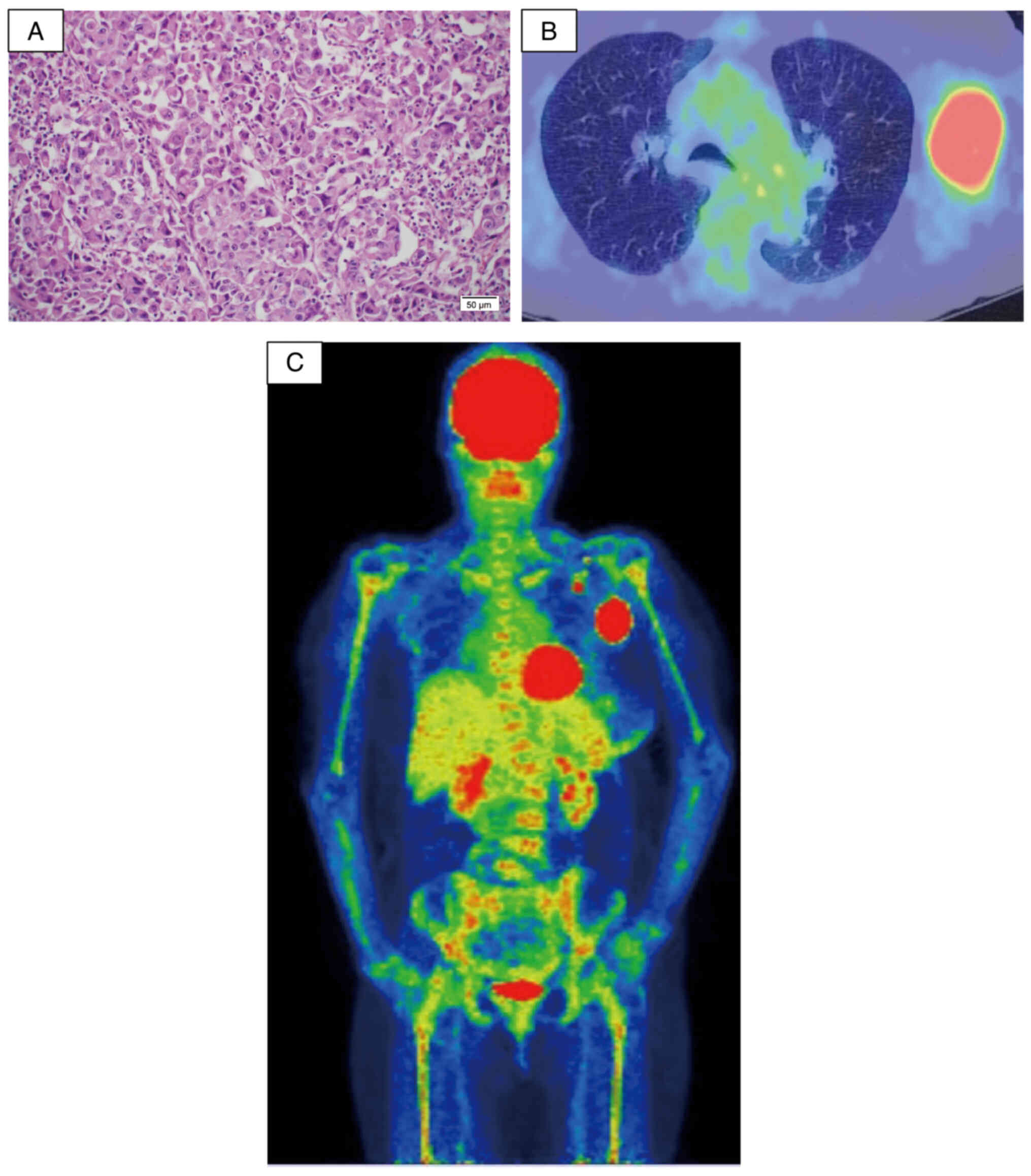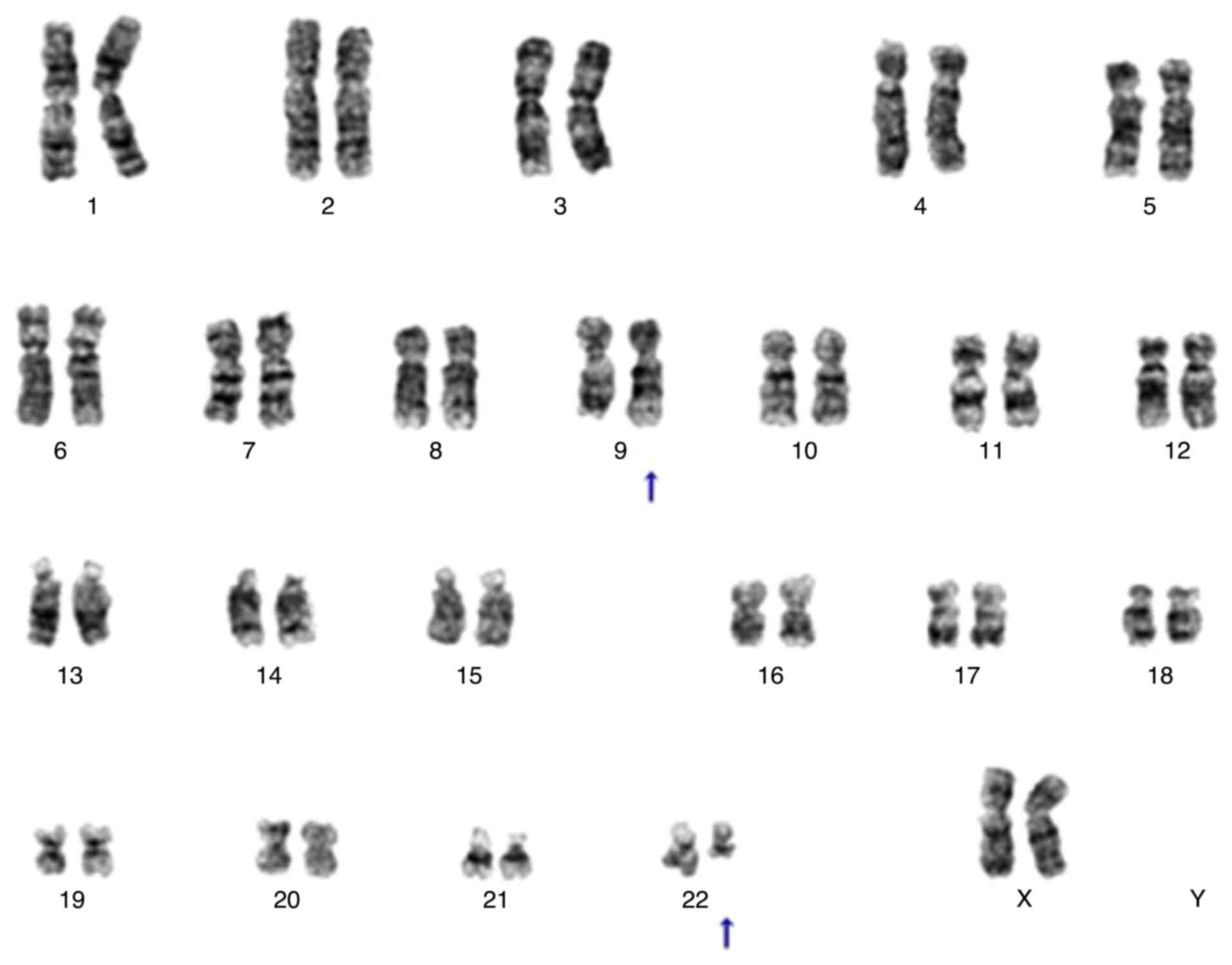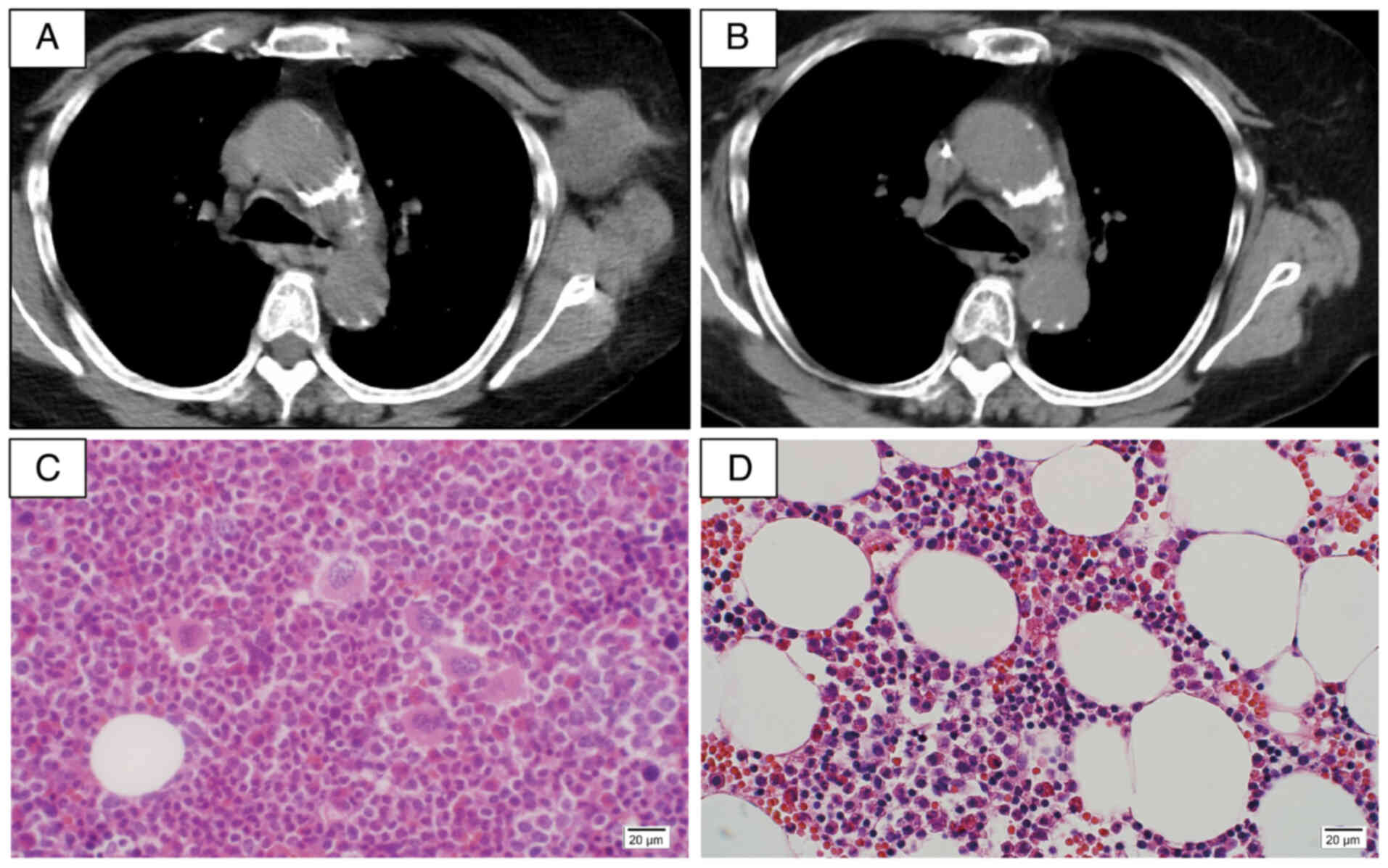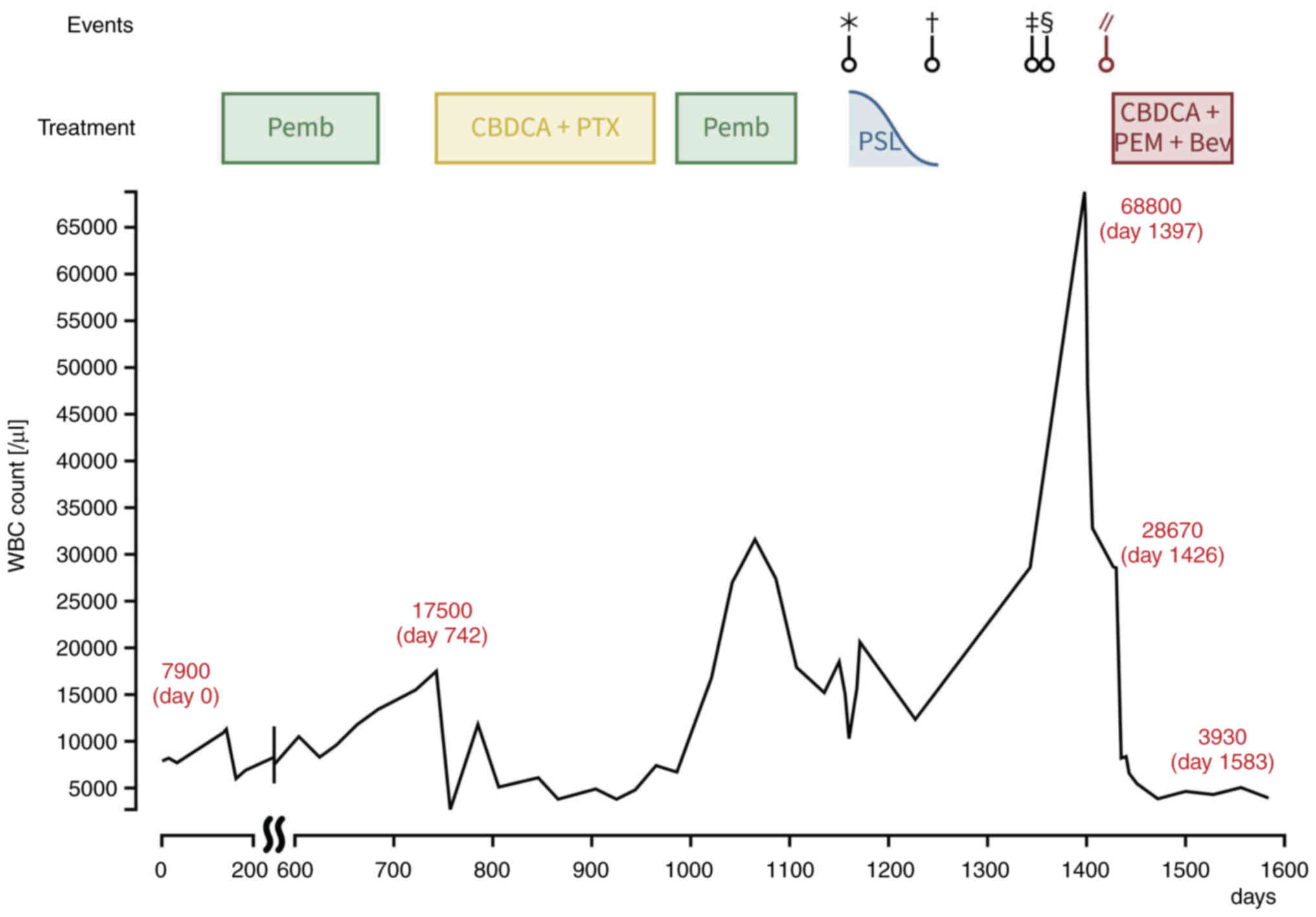Treatment of lung adenocarcinoma with chemotherapy helps mitigate chronic myeloid leukaemia progression: A case report
- Authors:
- Published online on: October 25, 2024 https://doi.org/10.3892/ol.2024.14777
- Article Number: 31
-
Copyright: © Nagasue et al. This is an open access article distributed under the terms of Creative Commons Attribution License.
Abstract
Introduction
There has been an improvement in the outcomes of chemotherapy for inoperable advanced non-small cell lung cancer (NSCLC) in recent years owing to the use of targeted therapies for driver mutations and immune checkpoint inhibitors (ICIs). Long-term survival can be expected, especially when ICIs are used in cases with high PD-L1 expression (1). Additionally, the perioperative use of these drugs has increased the number of curable cases (2). However, the incidence of secondary primary cancers and multiple primary malignancies is expected to increase with prolonged treatment (3). Managing these overlapping cancers can be challenging due to the difficulty in determining treatment priorities and maintaining overall patient condition. The administration of platinum-based agents such as carboplatin, commonly used in NSCLC treatment, has been associated with the development of therapy-related myeloid neoplasms (t-MNs) due to their cytotoxic effects and propensity to accumulate in bone tissue (4). This accumulation can potentially impact bone marrow function and contribute to secondary malignancies, including CML (5). As the number of long-term survivors of NSCLC increases, recognizing and managing the risk of t-MNs as a delayed complication is essential. Chronic myeloid leukaemia (CML), a type of myeloproliferative neoplasm (MPN), is characterised by the translocation of t(9;22)(q34;q11), resulting in the formation of the BCR-ABL1 fusion gene. Gene activation at the haematopoietic stem cell level causes tumorigenesis. Introducing tyrosine kinase inhibitors (TKIs) has improved treatment outcomes, and the development of improved next-generation agents is ongoing (6,7). However, few cases of CML development during NSCLC treatment have been reported to date.
Case report
A 66-year-old woman, who was a former smoker, presented with a neck mass at Asahikawa Medical University, Asahikawa, Hokkaido, Japan. Computed tomography (CT) scans revealed a tumour in the left upper lobe of the lung and bilateral cervical lymphadenopathy. Right cervical lymph node biopsy revealed lung adenocarcinoma (cT4N3M1b Stage IVA). The OncoMine Dx Target Test Multi-CDx System (ODxTT) (Life Technologies Corporation, Frederick Facility, USA) identified a KRAS G61L mutation. Programmed cell death ligand 1 (PD-L1) tumour proportion score (TPS) was 80–90%, indicating high expression. The patient received pembrolizumab as the first-line treatment, followed by carboplatin and paclitaxel as second-line therapies. Following the reinitiation of pembrolizumab as third-line therapy, the patient experienced anorexia and was subsequently diagnosed with immune-related gastritis. Corticosteroid treatment resulted in clinical improvement. At this point, since the lesion was confined to the left axillary lymph node, excisional surgery was performed. However, local recurrence was observed three months postoperatively. After delayed treatment for a urinary tract infection, the patient was admitted for the initiation of fourth-line treatment.
On admission to Asahikawa Medical University, her Eastern Cooperative Oncology Group performance status (ECOG-PS) was 1. Physical examination revealed a painless, immobile, hen-egg-sized lymph node in the left axilla. Blood tests showed an increased white blood cell (WBC) count to 28,670/µl. Chest CT revealed enlargement of the left axillary lymph node and disappearance of the primary lesion in the left upper lobe. The spleen was not enlarged. A tissue biopsy of the left axillary lymph node indicated metastasis of poorly differentiated cancer cells (Fig. 1A), consistent with metastatic adenocarcinoma confirmed by immunohistochemistry. During hospitalisation, despite no signs of infection or a history of corticosteroid administration in the past month, there was a gradual increase in the WBC count. 18F-fluoro-D-deoxyglucose positron emission tomography (FDG-PET) revealed high uptake in the left axillary lymph nodes and diffuse bone uptake (Fig. 1B and C). These imaging findings suggested diffuse bone metastasis, haematological disease, and local recurrence in the left axilla. Further examinations were conducted, including serum granulocyte colony-stimulating factor (G-CSF) levels and bone marrow biopsy. Serum G-CSF levels were normal, ruling out G-CSF-producing tumours. The bone marrow smear showed a nucleated cell count of 629,500/µl, a myeloid/erythroid (M/E) ratio of 5.32, and megakaryocyte hyperplasia at 368/µl. No dysplasia was observed in granulocytic, erythroid, or megakaryocytic lineages. There was no increase in blast cells, and the differentiation of the three haematopoietic lineages appeared normal. No abnormal cells or cell clusters suggestive of bone marrow metastasis from the cancer were detected. Chromosomal analysis of bone marrow fluid using G-banding revealed a karyotype of 46, XX, t(9;22) (q34.1;q11.2) [20/20], leading to a definitive diagnosis of CML (Fig. 2). Based on these findings, the patient was diagnosed with concurrent lung adenocarcinoma and CML. Notably, the time from the initial administration of carboplatin, an alkylating agent, to the diagnosis of CML was approximately 22 months, a relatively short period for disease onset.
Given the rapid postoperative regrowth of lung cancer and the completion of third-line therapy, lung cancer is considered a prognostic determinant. However, the treatment of CML is conservative because of its chronic disease phase. Therefore, when chemotherapy was administered for treating lung cancer, a cautious observational approach was adopted for CML. Carboplatin + pemetrexed + bevacizumab therapy was initiated as the fourth-line treatment. Six courses were completed without severe adverse events, and CT showed a reduced size of the left axillary lymph node (Fig. 3A and B). Upon re-evaluation of the bone marrow aspirate, the smear showed a nucleated cell count of 60,000/µl, an M/E ratio of 2.84, and normocellular marrow with 16/µl megakaryocytes, indicating improvement compared to the time of CML diagnosis (Fig. 3C and D). Peripheral blood BCR-ABL1IS, used to assess the therapeutic response in CML, remained stable, shifting from 3.60 to 4.26% over three months concurrent with chemotherapy for lung cancer, suggesting that the disease activity of CML was under control (Fig. 4). Following the hospital stay, the patient's follow-up care was transferred to a local hospital near her residence, and further monitoring at our institution was discontinued.
Discussion
The emergence of immune checkpoint inhibitors has increased the number of long-term survivors of advanced NSCLC (1). Consequently, the incidence of secondary primary cancers and multiple primary malignancies is expected to increase. Patients who undergo cytotoxic chemotherapy or radiation therapy, which causes DNA damage, are at risk of developing therapy-related myeloid neoplasms (t-MNs), including acute myeloid leukaemia (t-AML), myelodysplastic syndrome (t-MDS), and myelodysplastic syndrome/myeloproliferative neoplasm (t-MDS/MPN) (8). The administration of alkylating agents has been identified as a risk factor for the development of t-MNs, and the time from administration to the onset of t-MNs is 5–7 years (9). Additionally, platinum-based agents such as carboplatin have a known propensity to accumulate in bone tissue and impact bone marrow function, potentially contributing to the development of myeloid neoplasms (4). As the number of long-term survivors of NSCLC increases, the potential of t-MN as a delayed complication should be recognized. In the present case, the time from the initial administration of carboplatin, an alkylating agent, to the diagnosis of CML was approximately 22 months, a relatively short period for disease onset. Therefore, the possibility of co-exposures or confounders other than alkylating agents, such as radiation exposure or genetic mutations involved in DNA repair, cannot be ruled out (9). The abbreviated onset period may be related to using an immune checkpoint inhibitor. t-AML can develop during pembrolizumab treatment (10). Immune checkpoint inhibitors enhance the development of t-MNs after exposure to alkylating agents. However, the patient's WBC count increased to approximately 20,000/µl before carboplatin administration (Fig. 3). De novo CML may have been present before treatment with an alkylating agent; however, differentiation between de novo carcinogenesis and t-MN is challenging because of the lack of distinguishing molecular mechanisms.
The natural progression of CML typically commences with a chronic phase lasting 3–5 years, characterised by minimal symptoms, followed by an accelerated phase, during which there is progressive impairment in the maturation and differentiation of granulocytes, culminating in a blast phase. Disease staging was performed according to the World Health Organization classification, with the cases in question categorised under the chronic phase (11). EUTOS and Sokal scores were used for prognostic stratification (12). Based on the EUTOS score, a prognostic model established from patient outcomes treated with imatinib, this patient was categorised into the low-risk group and exhibited a 90% progression-free survival five years post-treatment initiation, markedly surpassing the outcomes associated with NSCLC. In the present case, lung cancer was considered a prognostic factor because of the rapid progression of postoperative re-growth and the fact that the patient had completed tertiary treatment; therefore, the patient was treated with chemotherapy for lung cancer while CML was carefully monitored.
The patient's lung cancer had responded to treatment by the end of six courses of carboplatin, pemetrexed, and bevacizumab therapy. Simultaneously, bone marrow puncture showed improvement in nucleated cell count, M/E ratio, and megakaryocyte count, and BCR-ABL1IS in peripheral blood remained unchanged from 3.60 to 4.26% over 3 months following chemotherapy for lung cancer, suggesting that the disease of CML was controlled. Carboplatin has been used as multi-agent chemotherapy for CML in the blastic phase and is effective in inducing remission (5). Pemetrexed is not generally used to treat CML. However, it exerts an anticancer effect by inhibiting DNA synthesis through the antagonism of folate metabolism, which may suppress cell proliferation in leukaemia. Ponatinib, a TKI indicated for CML, is expected to be used in NSCLC treatment but evidence to support its use is insufficient (13). There are no reports on the safety of TKIs in combination with chemotherapy for lung cancer. Therefore, chemotherapy for lung cancer with the expectation of controlling CML may be an effective treatment option. Naturally, observations should be made with an eye toward the sequential use of TKI, because deep remission cannot be expected without it.
In conclusion, this case illustrates that a lung cancer chemotherapy regimen can mitigate CML progression. With the evolving long-term survival rates of lung cancer, the incidence of concurrent malignancies and secondary cancer development, such as CML, along with lung cancer, as observed in this case, is anticipated to increase. Therefore, it is crucial to identify such cases and strategically prioritise their management for lung cancer treatment to ensure optimal therapeutic outcomes.
Acknowledgements
Not applicable.
Funding
Funding: No funding was received.
Availability of data and materials
The data generated in the present study may be requested from the corresponding author. The OncoMine Dx Target Test Multi-CDx System data generated in the present study are not publicly available due to ethical restrictions but may be requested from the corresponding author.
Authors' contributions
KNa was involved in the material preparation, data collection, data curation and visualization and wrote the original draft. RK conceived the study and reviewed and edited the manuscript. RS, KNi, AY, HY, YU, CM and YM were involved in the material preparation and data collection. TF, MY and MT collected data, were involved in revising the manuscript critically for important intellectual content and supervised the study. RY conceived the study, performed analysis, reviewed and edited the manuscript, and supervised the study. TS conceived the study, was involved in project administration and supervised the study. KNa, RK, RY and TS confirm the authenticity of all the raw data. All authors have read and approved the final manuscript.
Ethics approval and consent to participate
Not applicable.
Patient consent for publication
Written informed consent was obtained from the relative of the patient for publication of the details of the medical case.
Competing interests
The authors declare that they have no competing interests.
Glossary
Abbreviations
Abbreviations:
|
NSCLC |
non-small cell lung cancer |
|
CML |
chronic myeloid leukaemia |
|
MPN |
myeloproliferative neoplasm |
|
WBC |
white blood cell |
|
t-MN |
therapy-related myeloid neoplasms |
|
TKIs |
tyrosine kinase inhibitors |
|
PD-L1 |
programmed cell death ligand 1 |
|
TPS |
tumour proportion score |
|
ECOG-PS |
Eastern Cooperative Oncology Group performance status |
|
FDG-PET |
18F-fluoro-D-deoxyglucose positron emission tomography |
|
G-CSF |
granulocyte colony-stimulating factor |
|
M/E |
myeloid/erythroid |
|
AML |
acute myeloid leukaemia |
|
MDS |
myelodysplastic syndrome |
|
MDS/MPN |
myelodysplastic syndrome/myeloproliferative neoplasm |
References
|
Reck M, Rodríguez-Abreu D, Robinson AG, Hui R, Csőszi T, Fülöp A, Gottfried M, Peled N, Tafreshi A, Cuffe S, et al: Five-year outcomes with pembrolizumab versus chemotherapy for metastatic non-small-cell lung cancer with PD-L1 tumor proportion score ≥ 50. J Clin Oncol. 39:2339–2349. 2021. View Article : Google Scholar : PubMed/NCBI | |
|
Wakelee H, Liberman M, Kato T, Tsuboi M, Lee SH, Gao S, Chen KN, Dooms C, Majem M, Eigendorff E, et al: Perioperative pembrolizumab for early-stage non-small-cell lung cancer. N Engl J Med. 389:491–503. 2023. View Article : Google Scholar : PubMed/NCBI | |
|
Tabuchi T, Ito Y, Ioka A, Miyashiro I and Tsukuma H: Incidence of metachronous second primary cancers in Osaka, Japan: Update of analyses using population-based cancer registry data. Cancer Sci. 103:1111–1120. 2012. View Article : Google Scholar : PubMed/NCBI | |
|
Travis LB: The epidemiology of second primary cancers. Cancer Epidemiol Biomarkers Prev. 15:2020–2026. 2006. View Article : Google Scholar : PubMed/NCBI | |
|
Montefusco E, Petti MC, Alimena G, Latagliata R, Celesti F, Capria S, Amadori S, Avvisati G and Mandelli F: Etoposide, intermediate-dose cytarabine and carboplatin (VAC): A combination therapy for the blastic phase of chronic myelogenous leukemia. Ann Oncol. 8:175–179. 1997. View Article : Google Scholar : PubMed/NCBI | |
|
Kantarjian H, O'Brien S, Jabbour E, Garcia-Manero G, Quintas-Cardama A, Shan J, Rios MB, Ravandi F, Faderl S, Kadia T, et al: Improved survival in chronic myeloid leukemia since the introduction of imatinib therapy: A single-institution historical experience. Blood. 119:1981–1987. 2012. View Article : Google Scholar : PubMed/NCBI | |
|
Wylie AA, Schoepfer J, Jahnke W, Cowan-Jacob SW, Loo A, Furet P, Marzinzik AL, Pelle X, Donovan J, Zhu W, et al: The allosteric inhibitor ABL001 enables dual targeting of BCR-ABL1. Nature. 543:733–737. 2017. View Article : Google Scholar : PubMed/NCBI | |
|
Koo SM, Kim KU, Kim YK and Uh ST: Therapy-related myeloid leukemia during erlotinib treatment in a non-small cell lung cancer patient: A case report. World J Clin Cases. 9:7205–7211. 2021. View Article : Google Scholar : PubMed/NCBI | |
|
McNerney ME, Godley LA and Le Beau MM: Therapy-related myeloid neoplasms: When genetics and environment collide. Nat Rev Cancer. 17:513–527. 2017. View Article : Google Scholar : PubMed/NCBI | |
|
Kim HB, Park SG, Hong R, Kang SH and Na YS: Acute myelomonocytic leukemia during pembrolizumab treatment for non-small cell lung cancer: A case report. World J Clin Cases. 8:2833–2840. 2020. View Article : Google Scholar : PubMed/NCBI | |
|
Arber DA, Orazi A, Hasserjian R, Thiele J, Borowitz MJ, Le Beau MM, Bloomfield CD, Cazzola M and Vardiman JW: The 2016 revision to the World Health Organization classification of myeloid neoplasms and acute leukemia. Blood. 127:2391–2405. 2016. View Article : Google Scholar : PubMed/NCBI | |
|
Hasford J, Baccarani M, Hoffmann V, Guilhot J, Saussele S, Rosti G, Guilhot F, Porkka K, Ossenkoppele G, Lindoerfer D, et al: Predicting complete cytogenetic response and subsequent progression-free survival in 2060 patients with CML on imatinib treatment: The EUTOS score. Blood. 118:686–692. 2011. View Article : Google Scholar : PubMed/NCBI | |
|
Ren M, Hong M, Liu G, Wang H, Patel V, Biddinger P, Silva J, Cowell J and Hao Z: Novel FGFR inhibitor ponatinib suppresses the growth of non-small cell lung cancer cells overexpressing FGFR1. Oncol Rep. 29:2181–2190. 2013. View Article : Google Scholar : PubMed/NCBI |














